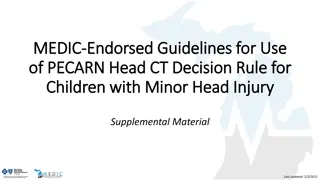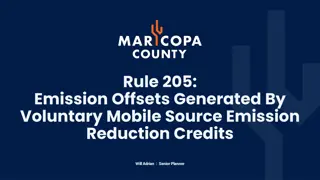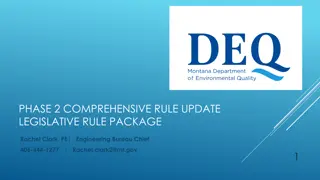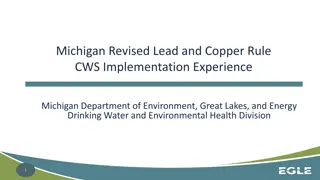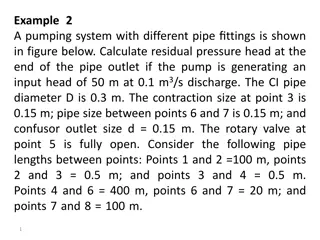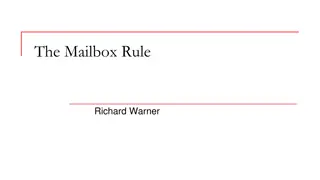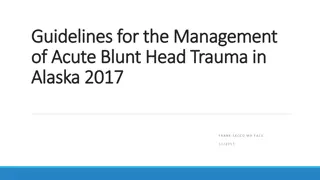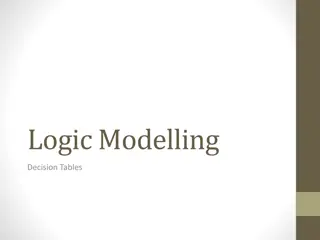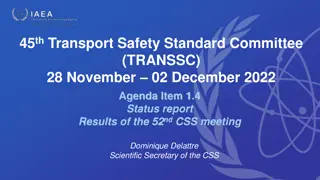MEDIC Endorsed Guidelines: PECARN Head CT Decision Rule
Learn about the MEDIC Endorsed Guidelines for utilizing the PECARN Head CT Decision Rule in children with minor head injuries. Understand why standardizing ED guidelines for head CT use in children is crucial to reduce overuse and improve patient care.
Download Presentation

Please find below an Image/Link to download the presentation.
The content on the website is provided AS IS for your information and personal use only. It may not be sold, licensed, or shared on other websites without obtaining consent from the author. Download presentation by click this link. If you encounter any issues during the download, it is possible that the publisher has removed the file from their server.
E N D
Presentation Transcript
MEDIC MEDIC- -Endorsed Guidelines for Use Endorsed Guidelines for Use of PECARN Head CT Decision Rule for of PECARN Head CT Decision Rule for Children with Minor Head Injury Children with Minor Head Injury Supplemental Material Last updated: 8/15/2023 Uploaded to website: 9/6/2023
What is MEDIC? The Michigan Emergency Department Improvement Collaborative (MEDIC) was launched in 2015 as an emergency physician-led quality improvement Collaborative comprised of hospitals across Michigan. MEDIC partners with emergency physicians who work together to collect and analyze data, identify best practices based on medical evidence, and improve collective performance. Participating EDs submit data to a clinical registry maintained by the MEDIC Coordinating Center. Support for MEDIC is provided by Blue Cross Blue Shield of Michigan and Blue Care Network within the BCBSM Value Partnerships program.
Why Standardize ED Guidelines for Head CT Use in Children with Minor Head Injury? Overuse of head CT for minor head injury in the ED can be reduced through the application of clinical decision rules Overuse results in excess cost, radiation exposure, follow-up testing for incidental findings, overtreatment due to incidental findings Variation in care is present within and between EDs driven by Varying levels of experience and comfort with assessing children Concerns for liability and risk of missing clinically-important traumatic brain injury Strong evidence base provides clear indications for CT use in children with mild head injury Kuppermann N, et al. Identification of children at very low risk of clinically-important brain injuries after head trauma: a prospective cohort study. The Lancet. 2009;374(9696):1160-1170.
What is this rule? Internationally recognized Developed within the ED context for ED providers Widely utilized as standard-of-care To improve decision- making for CT ordering in evaluation of pediatric minor head injury Endorsed by MEDIC after careful, consensus-based vetting process Kuppermann N, et al. Identification of children at very low risk of clinically-important brain injuries after head trauma: a prospective cohort study. The Lancet. 2009;374(9696):1160-1170.
Why the PECARN Pediatric Head CT Rule? GOALS Implement current gold-standard for evidence-based care Derived prospectively in the ED setting Extensively studied & validated Widely utilized as standard-of-care RATIONALE Kuppermann N, et al. Identification of children at very low risk of clinically-important brain injuries after head trauma: a prospective cohort study. The Lancet. 2009;374(9696):1160-1170. LITERATURE
To whom does this rule apply? GOALS Define the pediatric population in which the PECARN decision rule can be applied The PECARN decision rule was studied and validated in the below population: GCS of 14 - 15 Children within 24 hours of head trauma Blunt head trauma, not penetrating More than trivial, but less than severe head injury Ages < 18 DEFINITION Kuppermann N, et al. Identification of children at very low risk of clinically-important brain injuries after head trauma: a prospective cohort study. The Lancet. 2009;374(9696):1160-1170. LITERATURE Lumba-Brown A, et al. Centers for Disease Control and Prevention Guideline on the Diagnosis and Management of Mild Traumatic Brain Injury Among Children [published correction appears in JAMA Pediatr. 2018 Nov 1;172(11):1104]. JAMA Pediatr. 2018;172(11):e182853.
Why tailor to <2 years & 2 years? To acknowledge the differences in communication and physiologic development of children younger than 2 years of ago and those who are 2 years and older GOALS The landmark PECARN article utilized the age cut point of < 2 and greater than/equal to 2 years to differentiate between the decision rules for pre-verbal and verbal children RATIONALE Kuppermann N, et al. Identification of children at very low risk of clinically-important brain injuries after head trauma: a prospective cohort study. The Lancet. 2009;374(9696):1160-1170. LITERATURE
What should I do if my patient has isolated vomiting, LOC, severe headache, severe mechanism of injury? To minimize CT use among intermediate risk patients with isolated vomiting, loss of consciousness (LOC), severe headache, or severe mechanism of injury GOALS Planned secondary analyses of the clinical features that make up the PECARN decision rule have revealed that several symptoms in isolation are not associated with clinically-important traumatic brain injury in children RATIONALE If a child is experiencing an isolated symptom, a provider can use shared decision making with family members to consider the risk-benefit of observation vs. obtaining a CT Dayan PS, et al. Association of Traumatic Brain Injuries With Vomiting in Children With Blunt Head Trauma. Annals of Emergency Medicine. 2014;63(6):657-665. Dayan PS, et al. Headache in Traumatic Brain Injuries From Blunt Head Trauma. Pediatrics. 2015;135(3):504-512. Lee LK, et al. Isolated Loss of Consciousness in Children With Minor Blunt Head Trauma. JAMA Pediatrics. 2014;168(9):837. Nigrovic LE, et al. Prevalence of Clinically Important Traumatic Brain Injuries in Children With Minor Blunt Head Trauma and Isolated Severe Injury Mechanisms. Arch Pediatr Adolesc Med. 2012;166(4):356 361 LITERATURE
Why the Head CT Choice Decision Aid? To facilitate shared decision-making with families of children who are in the intermediate risk group for clinically-important traumatic brain injury GOALS Shared decision-making tools have been shown to help patients and families make clinical decisions in partnership with their healthcare providers RATIONALE The Head CT Choice Decision Aid was specifically designed & tested for facilitating conversations in the ED with parents/guardians of children with minor head injury around decision to image Hess EP, et al. Effect of the Head Computed Tomography Choice Decision Aid in Parents of Children With Minor Head Trauma. JAMA Network Open. 2018;1(5). LITERATURE Knowledge and Evaluation Research Unit, https://carethatfits.org/head-ct-choice-desicion-aid/. Accessed December 2020.
What is this rule? Internationally recognized Developed within the ED context for ED providers Widely utilized as standard-of-care To improve decision- making for CT ordering in evaluation of pediatric minor head injury Endorsed by MEDIC after careful, consensus-based vetting process Kuppermann N, et al. Identification of children at very low risk of clinically-important brain injuries after head trauma: a prospective cohort study. The Lancet. 2009;374(9696):1160-1170.
Post-traumatic seizure in the PECARN rule Post-traumatic seizure (PTS) Is considered to be altered mental status (AMS) and is high risk for ci- TBI based on planned secondary analyses of PECARN data This is true for BOTH < 2 and > 2 y/o children In the rule, this means clinicians follow box 1 YES for both age categories and CT IS indicated. If PTS is present in EHR documentation abstractors record / check BOTH AMS and LOC boxes in the data registry. Badawy, M. K., et al. Prevalence of Brain Injuries and Recurrence of Seizures in Children with Posttraumatic Seizures. Academic Emergency Medicine. 2017;24(5):595-605.
Key References Badawy, M. K., et al. Prevalence of Brain Injuries and Recurrence of Seizures in Children with Posttraumatic Seizures. Academic Emergency Medicine. 2017;24(5):595-605. Ballard DW, et al. Implementation of a Clinical Decision Support System for Children With Minor Blunt Head Trauma Who Are at Nonnegligible Risk for Traumatic Brain Injuries. Annals of Emergency Medicine. 2019;73(5):440-451. Dayan PS, et al. Association of Traumatic Brain Injuries With Vomiting in Children With Blunt Head Trauma. Annals of Emergency Medicine. 2014;63(6):657-665. Dayan PS, et al. Headache in Traumatic Brain Injuries From Blunt Head Trauma. Pediatrics. 2015;135(3):504-512. Dayan PS, et al. Risk of Traumatic Brain Injuries in Children Younger than 24 Months With Isolated Scalp Hematomas. Annals of Emergency Medicine. 2014;64(2):153-162. Hess EP, et al. Effect of the Head Computed Tomography Choice Decision Aid in Parents of Children With Minor Head Trauma. JAMA Network Open. 2018;1(5). Knowledge and Evaluation Research Unit, https://carethatfits.org/head-ct-choice-desicion-aid/. Accessed December 2020. Kuppermann N, et al. Identification of children at very low risk of clinically-important brain injuries after head trauma: a prospective cohort study. The Lancet. 2009;374(9696):1160-1170. Lee LK, et al. Isolated Loss of Consciousness in Children With Minor Blunt Head Trauma. JAMA Pediatrics. 2014;168(9):837. Lumba-Brown A, et al. Centers for Disease Control and Prevention Guideline on the Diagnosis and Management of Mild Traumatic Brain Injury Among Children [published correction appears in JAMA Pediatr. 2018 Nov 1;172(11):1104]. JAMA Pediatr. 2018;172(11):e182853. Nigrovic LE, et al. Prevalence of Clinically Important Traumatic Brain Injuries in Children With Minor Blunt Head Trauma and Isolated Severe Injury Mechanisms. Arch Pediatr Adolesc Med. 2012;166(4):356 361. Varano P, et al. Acute outcomes of isolated cerebral contusions in children with Glasgow Coma Scale scores of 14 to 15 after blunt head trauma. Journal of Trauma and Acute Care Surgery. 2015;78(5):1039-1043.






